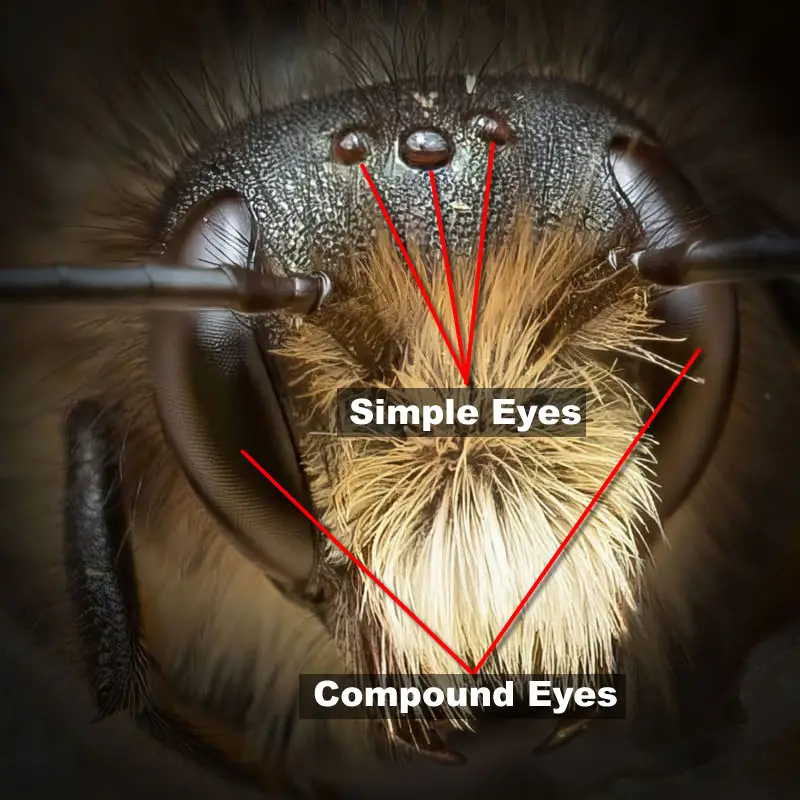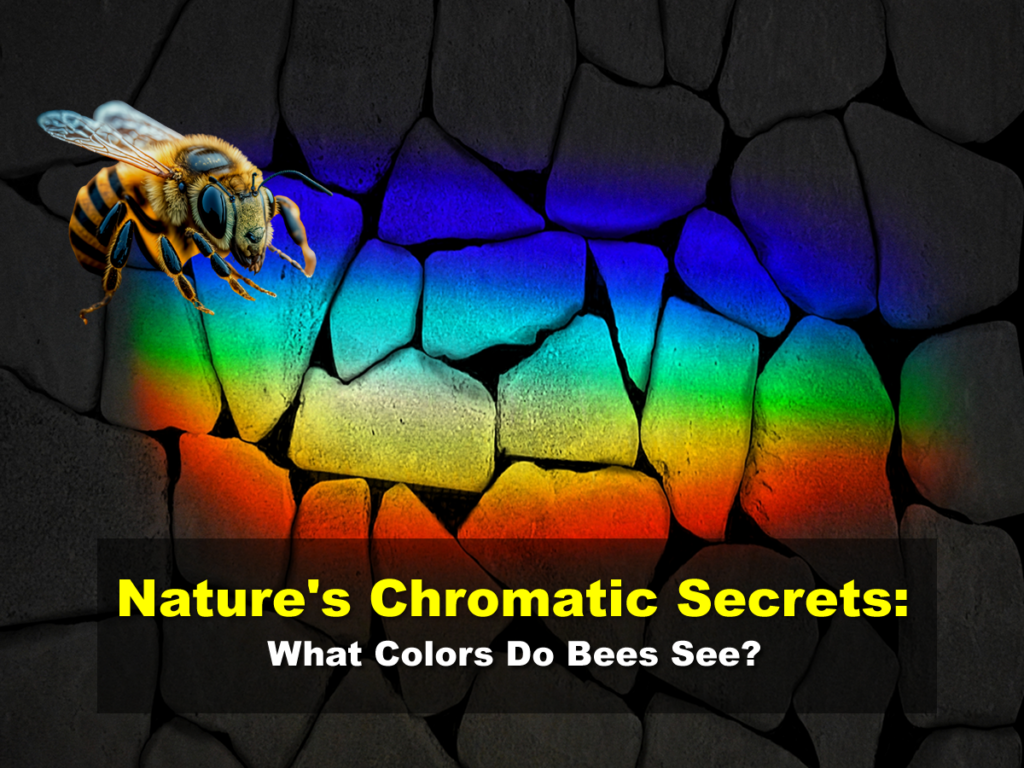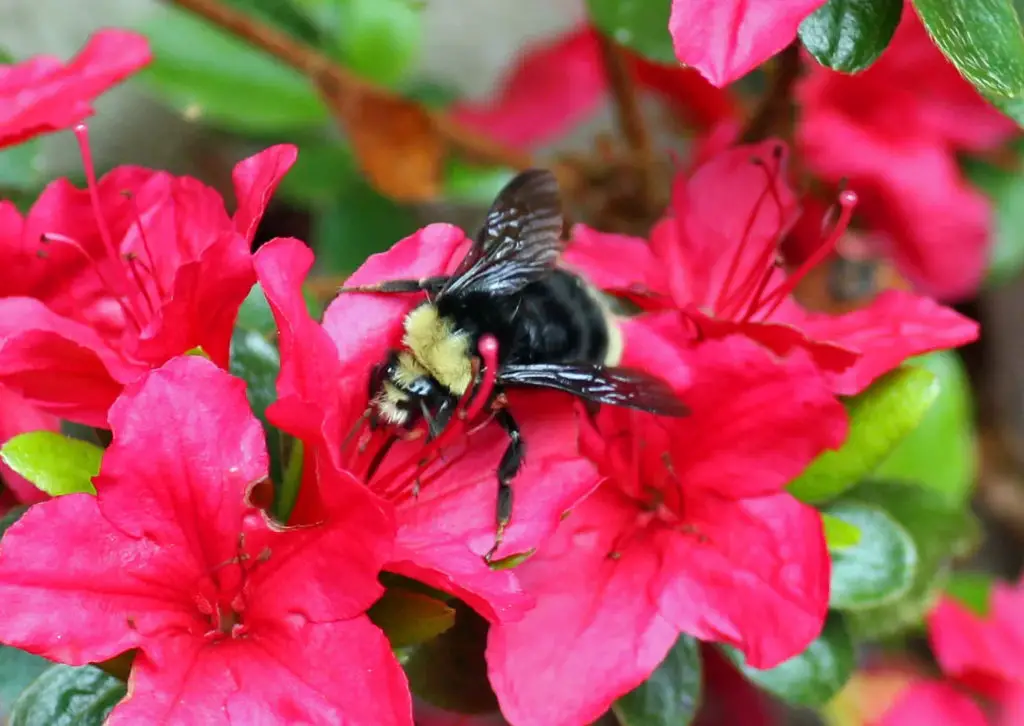Affiliate Disclaimer - As an Amazon Associate I earn from qualifying purchases.
It supports the website. So, Thank you
All animals see the world in different ways. That’s because of how each animal functions. For example, human vision would be useless to an owl and the way that dogs see would in no way benefit a marine animal like a shark. The way that bees see is pretty incredible and they even see a different color spectrum to us; but what colors do bees see?
According to scientists, bees are able to detect green and blue wavelengths as well as ultraviolet light. As a result of this, they can distinguish between various colors including black, white and several others.
You may have heard that bees cannot see the color red; that’s why people use red hummingbird feeders in order to throw bees off the scent. There are lots of other exciting facts about the way that bees see colors and I’d love to share them with you in this post!
Table of Contents
What Color Flowers Are Bees Most Attracted To?
If you see a bee flitting from flower to flower, you might not notice much of a pattern. That’s because bees can be seen on all kinds of flowers, in every color.
However, we should keep in mind that bees are much more easily able to see colors within the blue and green wavelengths so they’ll typically be found on flowers that are purple, blue, green, and yellow. While bees cannot see red as easily, they will often pollinate things like poppies which proves that the color of the flower is not the only thing that attracts them. Not to mention that they’re also attracted to UV markers on a plant but I’ll go into that in more detail later on.
Bees may be attracted to a flower because of its age and where it is in its development. Bees will opt for flowers that are as full as pollen and nectar as possible but when they’re very young and have just bloomed, they might not attract as many of our buzzing friends. That said, once a flower starts to fade away, a bee is not going to show as much interest, proving that old flowers are a no-go as well.
Another thing that might attract bees to a particular flower is the colors in the surrounding area. Moreover, a bee is likely to consider the attractiveness of other flowers in the area and opt for the one that draws them in the most. When assessing this, a bee will not only look at color but may also consider scent.
You also have to think about the fact that bees are taking their nutrition from plants so they’re highly unlikely to choose one whose flowers provide little to no nutritional value. These needs may change over the course of the season depending on the needs of the colony. In some cases, the bee may be attracted to nectar-rich flowers while at other times, it may go for flowers that are high in pollen.
So, Can Bees See Red?
The question that most people want an answer to when thinking about the vision of bees is whether they can actually see red or not.
Bees are trichromatic, just like humans. This essentially means that they have three color receptors at the back of each of the eyes. But there is a difference between human color receptors and those of bees. Where humans use their color receptors to detect shades of blue, green, and red, bees can only pick up on blue and green wavelengths. This means that, while they may be able to ‘see’ a red flower, they’re not able to determine the color as well as a human.
But this doesn’t mean that bee vision is inferior to our own. In fact, the opposite is true. Humans can only see visible light whereas bees possess the ability to see UV light. There are UV markings on flowers which is just one of the ways that bees navigate and choose flowers to visit.
For this reason, you may spot a bee on a red flower. But that isn’t because it was attracted by the color, instead it has spotted the UV light exuding from the plant.
Can Bees See Ultraviolet?
Following on from my previous point, bees are able to see ultraviolet light. This is really important in terms of collecting nectar and pollen. So important, in fact, that scientists have determined that when UV light is not present, bees’ natural foraging instincts are quelled.
But that’s unlikely to happen in the wild since nature has a very interesting adaptation to ensure that bees are always attracted to plants. Flowers possess UV markers for the sole purpose of attracting bees.
When this happens, there is an almost reflective mark on the flower that can be seen by the bees and also makes their perception of the visible light spectrum much more intense than our own. This method of attracting bees is so effective that even red flowers can use it to draw in pollinators.
It’s pretty impressive when you think about it because even though bees cannot detect colors in the same way that a human can, their experience is still effective enough that it ensures their survival and that of the plants they are visiting. This UV light appears as small spots on the flower and many bee lovers have compared them to landing strips that guide the bee towards its nectar reward!
If you want to get into the facts and figures behind this UV ability, consider that humans can only detect light between 700 and 400 nanometers. On the other hand, bees are able to see between 600 and 300 nanometers and going this low is what enables them to detect UV light.
How Do Bees Eyes Work?
Unlike humans, bees don’t just have two eyes. Well, they have two compound eyes which are made up of thousands of facets; a type of tiny lens and each of these allows the bee to see part of the overall image. When all of the pieces of the image are put together in the bee’s brain, it can then see the bigger picture. Interestingly, drone bees have more facets than worker bees. Typically speaking, a drone would have around 8600 while its worker sister might only have 6900.
Behind each of the facets is a tube as well as pigment cells and vision cells, collectively this makes up a unit known as the ommatidium. The tiny tubes within this unit are what allow the bee to detect colors thanks to the eight cells contained within. Half of the cells allow the bee to see yellow-green light while the other half work with blue and ultraviolet light.
Amazingly, bees are also able to see polarized light which only moves in a single direction as molecules in the air scatter photons into a single ray of light. While humans cannot see this, bee eyes are easily able to pick up on it and they use it as a built-in GPS system, allowing them to navigate the world by following the light. They’re able to do this even on an overcast day just by checking the light patterns in the sky.
Now, as well as those super complex compound eyes, bees also have three simple eyes which are located on the top of the head and look like three bumps. It’s these eyes that allow them to detect like and help them to navigate. The proper name for them is the ocelli and these eyes only have one lens which not only helps the bee with direction but also helps to keep it stable.

As I have already mentioned, bees are trichromatic even though their eyes don’t work in the same way as ours. But despite not being able to see the color red so well, bees have an amazing ability to see colors far quicker than we could ever dream of. In fact, it’s thought that their color vision is the fastest of any creature on the planet and that they’re able to see colors five times quicker than we are.
Imagine driving past a field of flowers; everything would just appear as one big blur of color. But to a bee, each color would be clear and easily distinguished from the next, which is why they don’t have any trouble choosing flowers even when they’re moving.
What’s even more interesting is that bees can also pick out a single flower from within a much larger group thanks to the way that the petals seem to change color. That’s not something that you or I could detect but for a bee with its UV vision, iridescence becomes much more obvious. When they see a flower that looks shiny, they associate this with sugar and that’s what attracts them to the plant.
Final Thoughts
The way we see the world through our own eyes is very different to how bees perceive the world. A lot of people have asked me what colors do bees see and the answer is very interesting.
Not only can bees see UV light but, thanks to the way their photoreceptors work, they also struggle to see the color red.
Unlike humans, bees have five eyes; three simple eyes and two compound eyes. Together, these optical structures allow the bee to see the world in a way that benefits it perfectly. From spotting UV light on flowers to being able to detect single colors much more quickly than we can, their vision may be unusual but it’s perfectly adapted to their needs.




